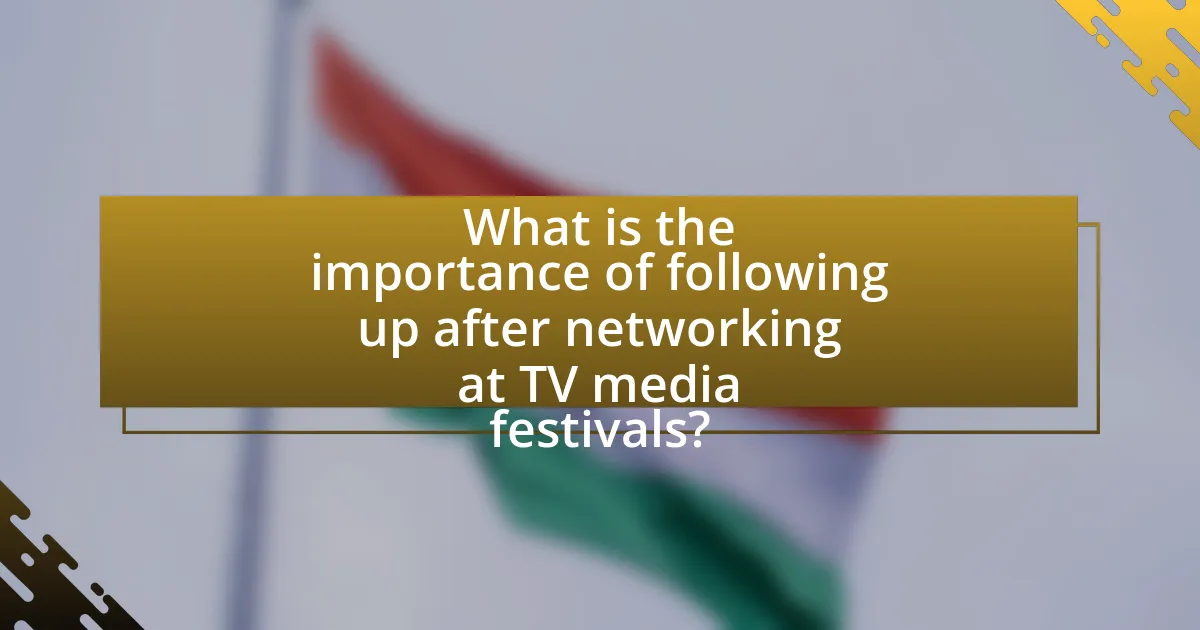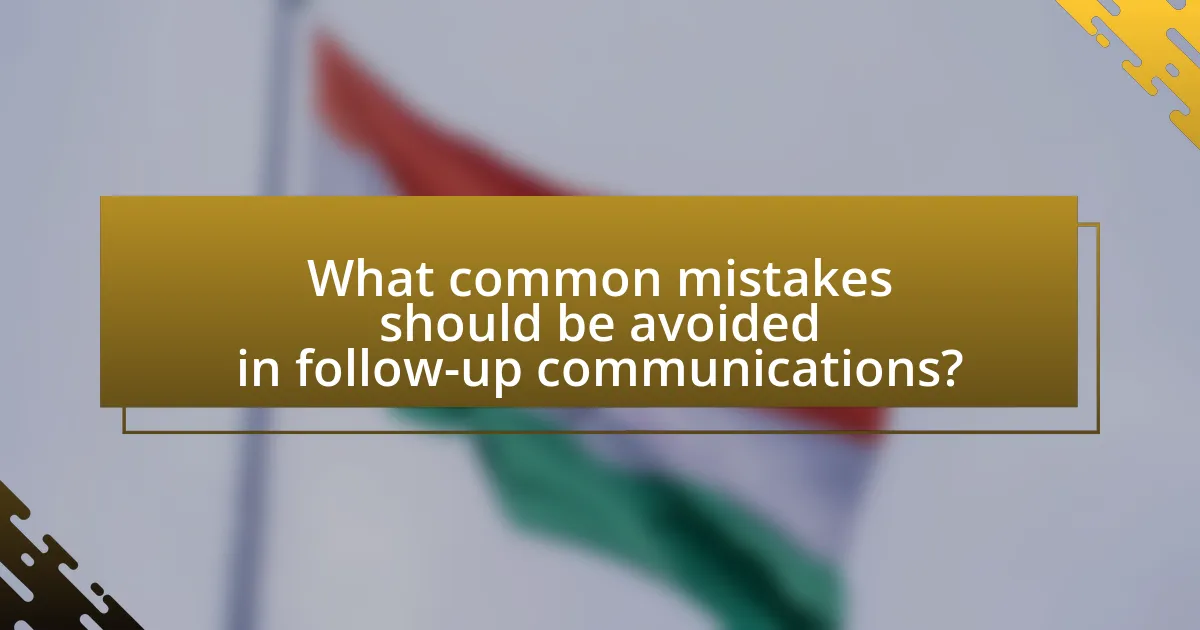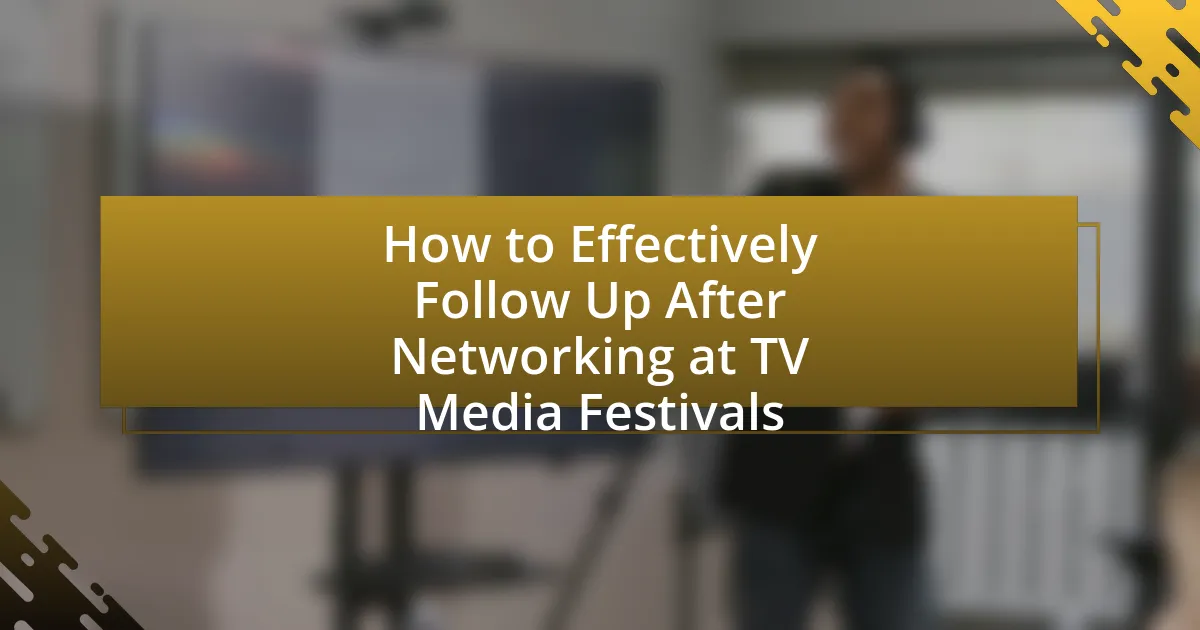The article focuses on the importance of effective follow-up after networking at TV media festivals, emphasizing how it strengthens professional relationships and enhances visibility. Key elements of successful follow-up include timely communication, personalization, and a clear value proposition, which collectively foster trust and rapport. The article outlines strategies for effective follow-up, the significance of timing, and the tools that can assist in the process, while also addressing common mistakes to avoid. By adhering to best practices, individuals can significantly improve their networking efforts and increase the likelihood of future opportunities.

What is the importance of following up after networking at TV media festivals?
Following up after networking at TV media festivals is crucial for establishing and maintaining professional relationships. This practice enhances visibility and reinforces connections made during the event, increasing the likelihood of future collaborations. Research indicates that 80% of sales require five follow-up calls after the initial meeting, highlighting the importance of persistence in professional networking. By reaching out, individuals demonstrate their interest and commitment, which can lead to opportunities such as job offers, partnerships, or mentorships.
How does effective follow-up impact professional relationships?
Effective follow-up strengthens professional relationships by demonstrating reliability and commitment. When individuals consistently follow up after networking events, they reinforce their interest in collaboration and maintain open lines of communication. Research indicates that 80% of sales require five follow-ups to close, highlighting the importance of persistence in professional interactions. This consistent engagement fosters trust and rapport, essential components for long-term professional relationships.
What are the key elements of a successful follow-up?
The key elements of a successful follow-up include timely communication, personalization, and clear value proposition. Timely communication ensures that the follow-up occurs shortly after the initial interaction, ideally within 24 to 48 hours, which helps maintain the connection and reinforces the relationship. Personalization involves referencing specific details from the initial conversation, demonstrating genuine interest and attention to the individual, which fosters rapport. A clear value proposition articulates how the follow-up can benefit the recipient, whether through sharing relevant resources, proposing collaboration, or offering assistance, thereby making the follow-up meaningful and actionable. These elements collectively enhance the effectiveness of follow-up efforts in networking contexts, such as TV media festivals.
How can follow-up enhance your networking efforts?
Follow-up enhances networking efforts by reinforcing connections made during initial interactions. When individuals follow up after networking events, they demonstrate professionalism and genuine interest, which can lead to stronger relationships. Research indicates that 80% of sales require five follow-up calls after the initial meeting, highlighting the importance of persistence in maintaining connections. Additionally, consistent follow-up can increase the likelihood of referrals and collaborations, as it keeps the individual top-of-mind for potential opportunities.
Why is timing crucial in the follow-up process?
Timing is crucial in the follow-up process because it directly influences the likelihood of a positive response from the individual being contacted. Following up too soon may come across as pushy, while waiting too long can result in the contact forgetting the initial interaction, diminishing the chances of engagement. Research indicates that the optimal follow-up window is typically within 24 to 48 hours after the initial meeting, as this timeframe capitalizes on the momentum of the networking event and keeps the conversation fresh in the recipient’s mind. This approach aligns with best practices in networking, where timely communication is essential for maintaining relationships and fostering opportunities.
What is the ideal timeframe for following up after a festival?
The ideal timeframe for following up after a festival is within 24 to 48 hours. This prompt follow-up helps to reinforce connections made during the event while the interactions are still fresh in both parties’ minds. Research indicates that timely communication increases the likelihood of a positive response, as it demonstrates enthusiasm and professionalism.
How does promptness affect the recipient’s perception?
Promptness significantly enhances the recipient’s perception by conveying professionalism and respect for their time. When a follow-up occurs quickly after networking, it demonstrates that the sender values the interaction and is eager to maintain the connection. Research indicates that timely responses can lead to increased trust and a stronger relationship, as recipients often interpret promptness as a sign of reliability and commitment. For instance, a study published in the Journal of Business Communication found that timely follow-ups positively influenced the perceived credibility of the sender, reinforcing the importance of promptness in professional networking contexts.

What strategies can be employed for effective follow-up?
Effective follow-up strategies include timely communication, personalized messages, and clear calls to action. Timely communication ensures that the connection remains fresh; research indicates that following up within 24 to 48 hours significantly increases the likelihood of a response. Personalized messages that reference specific conversations or shared interests demonstrate genuine engagement and help to build rapport. Additionally, incorporating a clear call to action, such as suggesting a meeting or requesting feedback, provides direction and encourages further interaction. These strategies are supported by networking studies that show personalized and prompt follow-ups lead to stronger professional relationships.
How can personalized messages improve follow-up effectiveness?
Personalized messages can significantly improve follow-up effectiveness by increasing engagement and fostering a sense of connection. When individuals receive tailored communications that reference specific interactions or shared interests, they are more likely to respond positively. Research indicates that personalized emails can lead to a 29% higher open rate and a 41% higher click-through rate compared to generic messages. This demonstrates that personalization not only captures attention but also encourages further interaction, making follow-ups more impactful in networking contexts such as TV media festivals.
What elements should be included in a personalized follow-up message?
A personalized follow-up message should include the recipient’s name, a reference to your previous interaction, a specific detail or insight from that conversation, and a clear call to action. Including the recipient’s name establishes a personal connection, while referencing the previous interaction shows attentiveness and reinforces the relationship. Mentioning a specific detail or insight demonstrates genuine interest and helps the recipient recall the conversation, making the message more memorable. Finally, a clear call to action guides the recipient on the next steps, whether it’s scheduling a meeting or continuing the discussion. These elements enhance the effectiveness of the follow-up and increase the likelihood of a positive response.
How can you tailor your message based on the connection made?
To tailor your message based on the connection made, first identify the specific interests and needs of the individual you connected with. For instance, if the person expressed interest in a particular project or topic during your conversation, reference that in your follow-up message. This approach personalizes your communication and demonstrates that you were actively listening. Research shows that personalized messages increase engagement rates by up to 29%, highlighting the effectiveness of this strategy. By aligning your message with the recipient’s interests, you enhance the likelihood of a positive response and foster a stronger professional relationship.
What tools can assist in the follow-up process?
Email management software, such as Mailchimp or Constant Contact, can assist in the follow-up process by enabling users to create and send personalized emails to contacts made during networking events. These tools provide features like segmentation, automation, and analytics, which enhance the effectiveness of follow-up communications. For instance, according to a study by Campaign Monitor, personalized emails can increase engagement rates by up to 29%. Additionally, customer relationship management (CRM) systems like Salesforce or HubSpot help track interactions and schedule follow-ups, ensuring that no connections are overlooked. These tools streamline the follow-up process, making it more efficient and organized.
Which digital platforms are best for networking follow-ups?
LinkedIn and email are the best digital platforms for networking follow-ups. LinkedIn allows users to connect professionally, share updates, and send direct messages, making it ideal for maintaining relationships established at events. Email provides a more personal touch, enabling detailed communication and the ability to attach documents or links relevant to the conversation. According to a 2021 survey by HubSpot, 86% of professionals prefer to use email for business communication, highlighting its effectiveness in follow-ups.
How can CRM systems enhance your follow-up strategy?
CRM systems enhance your follow-up strategy by centralizing customer data and automating communication processes. This centralization allows for personalized follow-ups based on previous interactions, ensuring that messages are relevant and timely. For instance, a study by Salesforce found that 70% of sales professionals believe that CRM systems improve customer relationships by providing insights into customer preferences and behaviors. Additionally, automation features enable reminders for follow-ups, reducing the risk of missed opportunities and increasing engagement rates. Thus, CRM systems significantly streamline and improve the effectiveness of follow-up strategies in networking contexts.

What common mistakes should be avoided in follow-up communications?
Common mistakes to avoid in follow-up communications include being overly aggressive, failing to personalize messages, and neglecting to provide value. Overly aggressive follow-ups can alienate contacts; research shows that 70% of professionals prefer a more measured approach. Failing to personalize messages can lead to disengagement, as generic communications are less likely to resonate; studies indicate that personalized emails have a 29% higher open rate. Lastly, neglecting to provide value in follow-ups can result in missed opportunities, as recipients are more likely to respond positively when they perceive a benefit, such as sharing relevant information or resources.
How can over-communication harm your networking efforts?
Over-communication can harm networking efforts by overwhelming contacts and leading to disengagement. When individuals receive excessive messages, they may feel pressured or annoyed, resulting in a negative perception of the sender. Research indicates that 70% of professionals prefer concise communication, as lengthy exchanges can dilute key messages and create confusion. This can ultimately damage relationships and reduce the likelihood of future collaboration.
What are the signs of excessive follow-up?
Signs of excessive follow-up include frequent and unsolicited messages, such as multiple emails or calls within a short time frame, which can overwhelm the recipient. Additionally, if the follow-up communications lack new information or context, they may be perceived as repetitive and intrusive. Research indicates that 70% of professionals feel annoyed by excessive follow-ups, highlighting the importance of maintaining a balance in communication.
How can you strike the right balance in follow-up frequency?
To strike the right balance in follow-up frequency, aim for a consistent yet respectful approach, typically following up once a week or bi-weekly after initial contact. This frequency allows you to remain on the recipient’s radar without overwhelming them, as studies show that excessive follow-ups can lead to disengagement. For instance, a survey by HubSpot indicates that 80% of sales require five follow-ups after the initial meeting, but the key is to space these out appropriately to maintain interest and avoid being perceived as intrusive.
What are the consequences of neglecting follow-up?
Neglecting follow-up after networking can lead to missed opportunities and weakened professional relationships. When individuals fail to follow up, they risk losing valuable connections that could lead to collaborations, job offers, or partnerships. Research indicates that 80% of sales require five follow-ups to close, highlighting the importance of persistence in maintaining relationships. Additionally, neglecting follow-up can result in a lack of visibility in one’s professional network, making it harder to be remembered or considered for future opportunities.
How does lack of follow-up affect future opportunities?
Lack of follow-up significantly diminishes future opportunities by creating a perception of disinterest or unreliability. When individuals fail to follow up after networking events, they miss the chance to reinforce connections, which can lead to lost collaborations, job offers, or partnerships. Research indicates that 80% of sales require five follow-up calls after the initial contact, highlighting the importance of persistence in building relationships. Without follow-up, potential opportunities may be overlooked, as connections fade and others fill the void.
What impact does it have on your professional reputation?
Following up effectively after networking at TV media festivals positively impacts your professional reputation by demonstrating reliability and professionalism. When individuals receive timely and thoughtful follow-ups, it reinforces their perception of you as a committed and engaged professional. Research indicates that 70% of professionals believe that consistent communication enhances their reputation within their industry. This consistent engagement fosters trust and can lead to future collaborations, thereby solidifying your standing in the media community.
What are the best practices for following up after networking?
The best practices for following up after networking include sending a personalized thank-you email within 24 to 48 hours, referencing specific topics discussed during the conversation to reinforce the connection. This approach demonstrates attentiveness and appreciation, which can strengthen relationships. Additionally, maintaining regular communication through updates or sharing relevant articles can keep the connection alive. Research indicates that timely follow-ups increase the likelihood of establishing meaningful professional relationships, as noted in studies by the Harvard Business Review, which emphasize the importance of prompt and personalized communication in networking contexts.
How can you create a follow-up schedule that works for you?
To create a follow-up schedule that works for you, first identify your key contacts and prioritize them based on the potential for collaboration or mutual benefit. Next, establish a timeline for follow-ups, such as one week after the initial meeting, and set reminders in your calendar to ensure consistency. Research indicates that timely follow-ups increase the likelihood of maintaining connections, with a study showing that 80% of sales require five follow-ups after the initial contact. By organizing your follow-up schedule around these principles, you can effectively nurture relationships formed at TV media festivals.
What tips can ensure your follow-up is memorable and effective?
To ensure your follow-up is memorable and effective, personalize your message by referencing specific details from your previous interaction. Personalization increases engagement; studies show that tailored communication can improve response rates by up to 50%. Additionally, express genuine appreciation for the connection made, as gratitude fosters positive relationships. Including a relevant article or resource can also add value to your follow-up, demonstrating your commitment to the relationship and providing useful information. Finally, maintain a clear and concise structure in your message to enhance readability and retention, as concise communication is often more impactful.

Leave a Reply